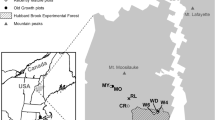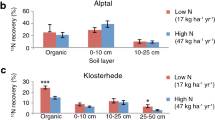Abstract
Sugar maple (Acer saccharum Marsh.)-dominated northern hardwood forests of the Great Lakes Region commonly receive elevated levels of atmospheric nitrate (NO −3 ) deposition, which can alter belowground carbon (C) cycling. Past research has demonstrated that chronic experimental NO −3 deposition (3 g N m−2 y−1 above ambient) elicits a threefold increase in the leaching loss of dissolved organic carbon (DOC). Here, we used DOC collected from tension-cup lysimeters to test whether increased DOC export under experimental NO −3 deposition originated from forest floor or mineral soil organic matter (SOM). We used DOC radiocarbon dating to quantify C sources and colorimetric assays to measure DOC aromaticity and soluble polyphenolic content. Our results demonstrated that DOC exports are primarily derived from new C (<50-years-old) in the forest floor under both ambient and experimental NO −3 deposition. Experimental NO −3 deposition increased soluble polyphenolic content from 25.03 ± 4.26 to 49.19 ± 4.23 μg phenolic C mg DOC−1, and increased total aromatic content as measured by specific UV absorbance. However, increased aromatic compounds represented a small fraction (<10%) of the total observed increased DOC leaching. In combination, these findings suggest that experimental NO −3 deposition has altered the production or retention as well as phenolic content of DOC formed in forest floor, however exact mechanisms are uncertain. Further elucidation of the mechanism(s) controlling enhanced DOC leaching is important for understanding long-term responses of Great Lakes forests to anthropogenic N deposition and the consequences of those responses for aquatic ecosystems.




Similar content being viewed by others
References
Berg B, Matzner E. 1997. Effect of N deposition on decomposition of plant litter and soil organic matter. Environ Rev 5:1–25
Burton AJ, Ramm CW, Pregitzer KS, Reed DD. 1991. Use of multivariate methods in forest research site selection. Can J Forest Res 21:1573–80
Burton AJ, Pregitzer KS, Crawford JN, Zogg GP, Zak DR. 2004. Simulated chronic NO −3 deposition reduces soil respiration in northern hardwood forests. Global Change Biol 10:1080–91
Carreiro MM, Sinsabaugh RL, Repert DA, Parkhurst DF. 2000. Microbial enzyme shifts explain litter decay responses to simulated nitrogen deposition. Ecology 81:2359–65
Cory RM, Gree SA, Pregitzer KS. 2004. Dissolved organic matter concentration and composition in the forests and streams of Olympic National Park, WA. Biogeochemistry 67:269–88
Currie WS, Aber JD, McDowell WH, Boone RD, Magill AH. 1996. Vertical transport of dissolved organic C and N under long-term N amendments in pine and hardwood forests. Biogeochemistry 35:471–505
Dalva M, Moore TR. 1991. Sources and sinks of dissolved organic-carbon in a forested swamp catchment. Biogeochemistry 15:1–19
DeForest JL, Zak DR, Pregitzer KS, Burton AJ. 2004a. Atmospheric nitrate deposition and the microbial degradation of cellobiose and vanillin in a northern hardwood forest. Soil Biol Biochem 36:965–71
DeForest JL, Zak DR, Pregitzer KS, Burton AJ. 2004b. Atmospheric nitrate deposition, microbial community composition, and enzyme activity in northern hardwood forests. Soil Sci Soc Am J 68:132–38
DeForest JL, Zak DR, Pregitzer KS, Burton AJ. 2005. Atmospheric nitrate deposition and enhanced dissolved organic carbon leaching: Test of a potential mechanism. Soil Sci Soc Am J 69:1233–37
Driscoll CT, Driscoll KM, Roy KM, Mitchell MJ. 2003. Chemical response of lakes in the Adirondack region of New York to declines in acidic deposition. Environ SciTechnol 37:2036–42
Eikenberry J. 2004. Chronic nitrate-addition alters northern hardwood root and leaf litter chemistry. MS Thesis. Michigan Technological University, Houghton
Evans CD, Monteith DT, Cooper DM. 2005. Long-term increases in surface water dissolved organic carbon: Observations, possible causes and environmental impacts. Environ Pollut 137:55–71
Findlay SEG. 2005. Increased carbon transport in the Hudson River: Unexpected consequence of nitrogen deposition? Frontiers Ecol Environ 3:133–37
Fog K. 1988. The effect of added nitrogen on the rate of decomposition of organic matter. Biol Rev 63:433–62
Gallo M, Amonette R, Lauber C, Sinsabaugh RL, Zak DR. 2004. Microbial community structure and oxidative enzyme activity in nitrogen-amended north temperate forest soils. Microb Ecol 48:218–29
Galloway JN, Cowling EB. 2002. Reactive nitrogen and the world: 200 years of change. Ambio 31: 64–71
Gaudinski JB, Trumbore SE, Davidson EA, Zheng SH. 2000. Soil carbon cycling in a temperate forest: Radiocarbon-based estimates of residence times, sequestration rates and partitioning of fluxes. Biogeochemistry 51:33–69
Green SA, Blough NV. 1994. Optical-absorption and fluorescence properties of chromophoric dissolved organic-matter in natural-waters. Limnol Oceanography 39:1903–16
Guggenberger G, Glaser B, Zech W. 1994. Heavy-metal binding by hydrophobic and hydrophilic dissolved organic-carbon fractions in a spodosol-A and spodosol-B-horizon. Water Air Soil Pollut 72:111–27
Hattenschwiler S, Vitousek PM. 2000. The role of polyphenols in terrestrial ecosystem nutrient cycling. Trends Ecol Evol 15:238–43
Kaiser K, Guggenberger G, Zech W. 1996. Sorption of DOM and DOC fractions to forest soils. Geoderma 74:281–303
Kaiser K, Guggenberger G, Haumaier L, Zech W. 2001. Seasonal variations in the chemical composition of dissolved organic matter in organic forest floor layer leachates of old-growth Scots Pine (Pinus sylvestris L.) and European Beech (Fagus sylvatica L.) stands in northeastern Bavaria, Germany. Biogeochemistry 55:103–43
Kalbitz K, Solinger S, Park JH, Michalzik B, Matzner E. 2000. Controls on the dynamics of dissolved organic matter in soils: A review. Soil Sci 165:277–304
Karltun E, Harrison AF, Alriksson A, Bryant C, Garnett MH, Olsson MT. 2005. Old organic carbon in soil solution DOC after afforestation - evidence from C-14 analysis. Geoderma 127: 188–95
Keyser P, Kirk TK, Zeikus JG. 1978. Ligninolytic enzyme-system of phanerochaete-chrysosporium - synthesized in absence of lignin in response to nitrogen starvation. J Bacteriol 135:790–97
Kirk TK, Farrell RL. 1987. Enzymatic combustion - the microbial-degradation of lignin. Ann Rev Microbiol 41:465–505
Lovett GM, Weathers KC, Arthur MA, Schultz JC. 2004. Nitrogen cycling in a northern hardwood forest: Do species matter? Biogeochemistry 67:289–308
Macdonald NW, Burton AJ, Jurgensen MF, McLaughlin JW, Mroz GD. 1993. Variation in forest soil properties along a Great-Lakes air-pollution gradient. Soil Sci Soc Am J 55:1709–15
McDowell WH, Likens GE. 1988. Origin, composition, and flux of dissolved organic-carbon in the Hubbard Brook valley. Ecol Monographs 58:177–95
Melillo JM, Aber JD, Muratore JF. 1982. Nitrogen and lignin control of hardwood litter decomposition dynamics. Ecology 63:621–26
Moldan F, Hultberg H, Nystrom U, Wright RF. 1995. Nitrogen saturation at Gårdsjon, Southwest Sweden, induced by experimental addition of ammonium-nitrate. Forest Ecol Manage 71:89–97
Neter J, Kutner MH, Nachtsheim CJ, Wasserman W. 1996. Applied linear statistical models. Boston, Massachusetts: WCB McGraw-Hill, p1408
Ohno T, First PR. 1998. Assessment of the Folin and Ciocalteu’s method for determining soil phenolic carbon. J Environ Quality 27:776–82
Paul EA, Follett RF, Leavitt SW, Halvorson A, Peterson GA, Lyon DJ. 1997. Radiocarbon dating of soil organic matter pool sizes and dynamics. Soil Sci Am J 61:1058–67
Perakis SS, Hedin LO. 2002. Nitrogen loss from unpolluted South American forests mainly via dissolved organic compounds. Nature 415:416–19
Pregitzer KS, Zak DR, Burton AJ, Ashby JA, MacDonald NW. 2004. Chronic nitrate additions dramatically increase the export of carbon and nitrogen from northern hardwood ecosystems. Biogeochemistry 68:179–97
Qualls RG, Haines BL. 1991. Geochemistry of dissolved organic nutrients in water percolating through a forest ecosystem. Soil Sci Soc Am J 55:1112–23
Qualls RG, Haines BL. 1992. Biodegradability of dissolved organic-matter in forest throughfall, soil solution, and stream water. Soil Sci Soc Am J 56:578–86
Richter DD, Markewitz D, Trumbore SE, Wells CG. 1999. Rapid accumulation and turnover of soil carbon in a re-establishing forest. Nature 400:56–58
Saiya-Cork KR, Sinsabaugh RL, Zak DR. 2002. The effects of long term nitrogen deposition on extracellular enzyme activity in an Acer saccharum forest soil. Soil Biol Biochem 34:1309–15
Schlesinger WH. 1990. Evidence from chronosequence studies for a low carbon-storage potential of soils. Nature 348:232–34
Sinsabaugh RL, Carreiro MM, Repert DA. 2002. Allocation of extracellular enzymatic activity in relation to litter composition, N deposition, and mass loss. Biogeochemistry 60:1–24
Smemo KA, Zak DR, Pregitzer KS. 2006. Chronic experimental NO −3 deposition reduces the retention of leaf litter DOC in a northern hardwood forest soil. Soil Biol Biochem 38:1340–47
Sposito G. 1989. The chemistry of soils. Oxford University Press, New York
Stuiver M, Polach HA. 1977. Reporting of D-14 data - discussion. Radiocarbon 19:355–63
Tipping E, Froberg M, Berggren D, Mulder J, Bergkvist B. 2005. DOC leaching from a coniferous forest floor: Modeling a manipulation experiment. J Plant Nut Soil Sci-Zeitschrift Fur Pflanzenernahrung Und Bodenkunde 168:316–24
Waldrop MP, Zak DR, Sinsabaugh RL, Gallo M, Lauber C. 2004. Nitrogen deposition modifies soil carbon storage through changes in microbial enzymatic activity. Ecol Appl 14:1172–77
Weishaar JL, Aiken GR, Bergamaschi BA, Fram MS, Fujii R, Mopper K. 2003. Evaluation of specific ultraviolet absorbance as an indicator of the chemical composition and reactivity of dissolved organic carbon. Environ Sci Technol 37:4702–08
Worrall F, Harriman R, Evans CD, Watts CD, Adamson J, Neal C, Tipping E, Burt T, Grieve I, Monteith D, Naden PS, Nisbet T, Reynolds B, Stevens P. 2004. Trends in dissolved organic carbon in UK rivers and lakes. Biogeochemistry 70:369–402
Zak DR, Grigal DF, Gleeson S, Tilman D. 1990. Carbon and nitrogen cycling during old-field succession - constraints on plant and microbial biomass. Biogeochemistry 11:111–29
Zech W, Guggenberger G, Schulten HR. 1994. Budgets and chemistry of dissolved organic-carbon in forest soils - effects of anthropogenic soil acidification. Sci Total Environ 152:49–62
Zogg GP, Zak DR, Pregitzer KS, Burton AJ. 2000. Microbial immobilization and the retention of anthropogenic nitrate in a northern hardwood forest. Ecology 81:1858–66
Acknowledgments
We would like to thank Chris Blackwood, Wendy Mahaney, Bridgett Emmett, and three anonymous reviewers for comments and advice on earlier drafts of this manuscript. Matt Tomlinson, Weiyin Xu, and Becky Mau provided invaluable field, laboratory and analytical help. Guaciara dos Santos provided invaluable advice and help with radiocarbon analysis and data interpretation. We also thank Michael Wiley for the kind permission to use lab space and the UV spec. Research funding for the Michigan Gradient Study has been provided by National Science Foundation grants DEB−9629842 and DEB-0075397.
Author information
Authors and Affiliations
Corresponding author
Rights and permissions
About this article
Cite this article
Smemo, K.A., Zak, D.R., Pregitzer, K.S. et al. Characteristics of DOC Exported from Northern Hardwood Forests Receiving Chronic Experimental NO −3 Deposition. Ecosystems 10, 369–379 (2007). https://doi.org/10.1007/s10021-007-9014-2
Received:
Accepted:
Published:
Issue Date:
DOI: https://doi.org/10.1007/s10021-007-9014-2




